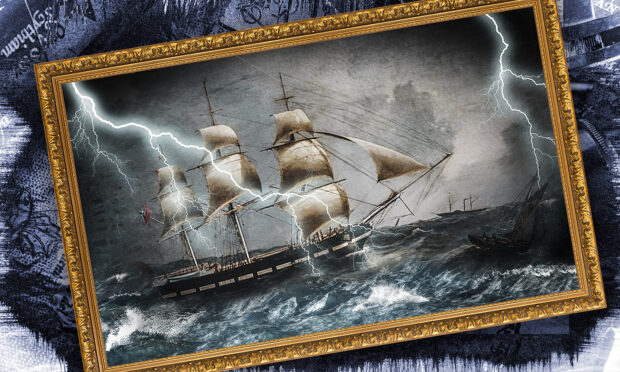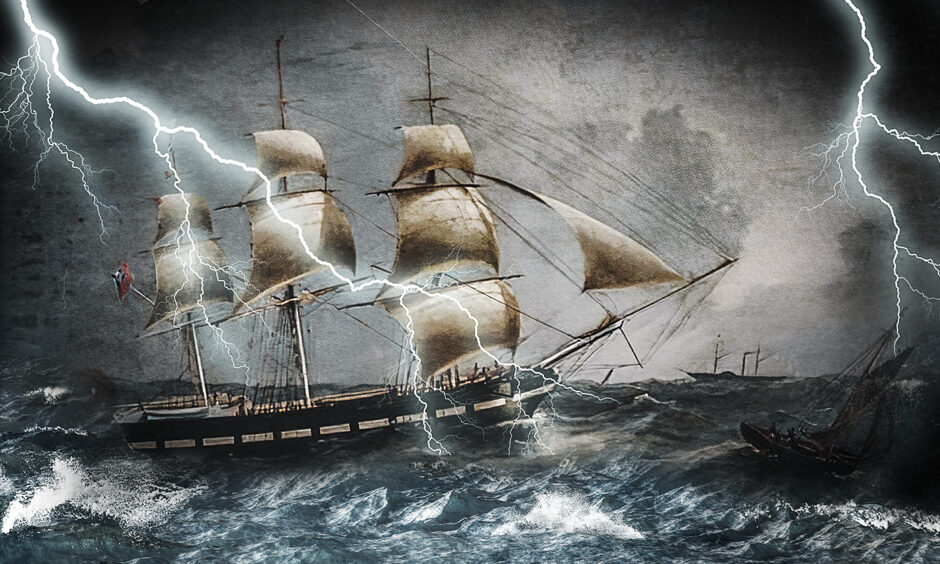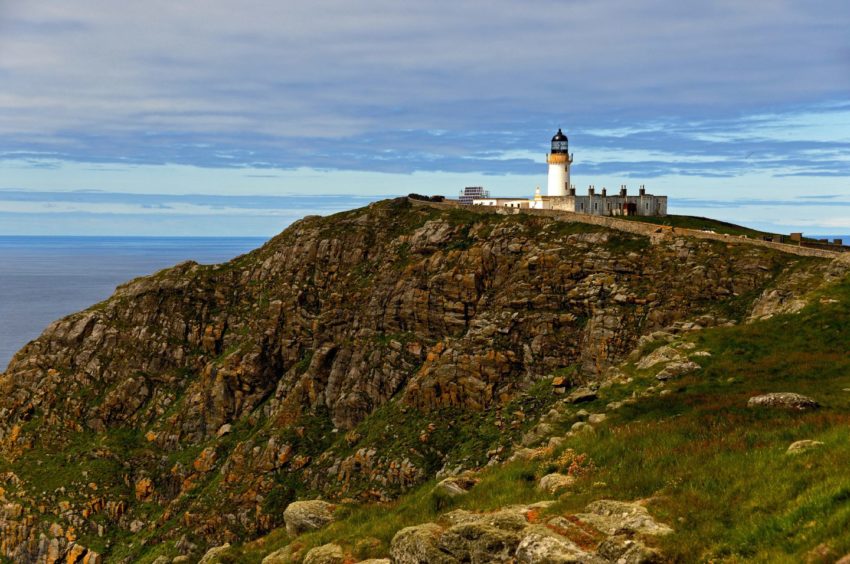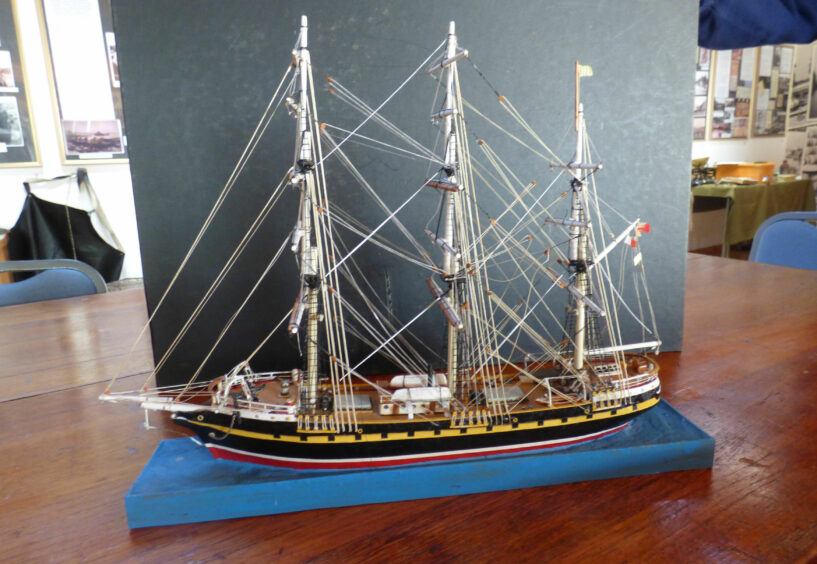Titanic usually tops the maiden-voyage-from-hell league table.
But what happened in Hebridean waters to the hundreds of souls aboard the brand-new Annie Jane on September 28 1853 is every bit as harrowing and one of the worst maritime disasters ever to befall Great Britain.
Ferocious weather, a captain under pressure, badly stowed cargo and 400 souls dreaming of a better life in Canada all came together to create a tragedy of epic proportions.
There were warnings, and it could have ended very differently.
But when the full-rigged, purpose-built emigrant boat set off from Liverpool bound for Quebec on August 23 1853, the die was cast.
On board Annie Jane were more than 400 passengers, mostly emigrants, barrels of meat and, fatefully, a cargo of iron rails.
Most of the passengers were from Scotland, a good number from Ireland, some Germans and a few French.
The ship’s crew were Canadians.
The initial sortie didn’t go well.
First signs of danger aboard emigrant ship Annie Jane
The ship met bad weather and due to the badly stowed railway iron, rolled heavily and lost two of her topmasts.
The passengers begged the skipper, Captain William Mason, to put back to Liverpool, which he did.
Things might have gone better after the refit, and six additional hands being taken aboard, when Annie Jane sailed again on September 9.
But a few days later, another heavy gale took away the topmasts once again, along with the lower mastheads.
They somehow managed to make repairs at sea, but the passengers begged Mason to turn back for Liverpool.
He turned the ship back – but under cover of darkness, set course again for Quebec.
‘To Quebec or the bottom!’
Contemporary newspaper accounts relate that, in the cold light of day, it became clear what had happened and “caused great sensation amongst the passengers, who remonstrated with the captain, but he expressed his determination to proceed”.
“To Quebec or the bottom!” shouted the captain, before threatening to shoot anyone who attempted to take his ship from him.
They were fateful words.
Seamen on board later said he had been put under pressure to continue the voyage by another captain aboard, wanting to press on to his destination in Canada.
On September 21 another gale once again took out the main topsail and mainyard.
They had to cut away the main topmast, “the ship rolling so much that the chain cable was dashed from one side of the deck to the other, making a noise like thunder, which mingled with the shrieks of passengers, was fearful.
“One of the seamen, a Canadian, had his legs broken by getting them entangled with the chain.”
The ship drifted, “nearly unmanageable in such a gale”, for several days until the island of Barra and its lighthouse hove into view on the night of September 28.
If the passengers felt relief that shore was within reach, it was short-lived.
From terrible to catastrophic
The captain headed for a small, sandy bay and things went from terrible to catastrophic.
She hit shore on the island of Vatersay shortly after midnight, first lightly, and then so heavily as to break the ship apart, “the passengers screaming dreadfully the whole of the time”.
After the second jolt, she turned broadside to the sea, which enabled the huge and ferocious waves to carry off anyone trying to hold on.
The jolt also flung the cabin doors shut, locking in anyone within.
Within seconds the poop deck sank, crushing hundreds, and in 10 minutes the ship was in pieces.
The poop deck floated, with dozens finding standing room on it – but many perished with the cold or were “smothered under the trampling of others”.
Many drowned trying to swim ashore or when their life boats capsized.
Wise after the event, it was said that if the passengers had stayed with the ship they all would have been saved as it was left high and dry by the receding tide, and those who remained on board survived.
Pity the passengers huddling in the cabin which had filled with water “drowning many of the unfortunate people who had fled there as a place of refuge”.
Exit blocked with bodies
The exit was blocked with bodies, and one of the survivors escaped via the skylight.
The chief mate and boatswain were lost, but Captain Mason and the chief officer remained aboard and ultimately survived.
The captain was praised for “using his best endeavours to save those on board”.
Food and accommodation were scarce, so it was an uncomfortable five days for the 102 survivors, although “the islanders used their best exertions to save the lives of the people on boards the vessel and treated those who were rescued with the greatest kindness”.
The survivors had to witness scores of mangled, mutilated, often naked bodies washing ashore, including whole families they must have got to know during their long and various ordeals aboard Annie Jane.
Mass grave
They were buried ‘like sardines in a barrel’ in a mass grave.
A memorial raised in 1881 now sits above the beach at Traigh Siar on Vatersay, and in 2018, a service was held to commemorate the 165th anniversary of the event.
Captain Mason wrote dispassionately to the ship’s owner, John H Holderness:
Dear sir, – I am sorry to inform you of the total loss of the Annie Jane, with about three-fourths of the passengers and crew aboard, which happened on the night of the 28th September, during a heavy gale from the westward, and which prevented me from clearing the land on either tack, the ship having been dismasted 36 hours after leaving Liverpool.
I three times got up spars on the stumps of the lower masts, but lost them shortly after, owing to violent gales which have continued ever since I left Liverpool.
I was drifted as far as lat. 60N. One hundred and two are all that are saved on board; only three cabin passengers remain.
Capt. Rose (who was on his way to take charge of another ship for the owner), Mrs Rose and the boy servant have been found and interred.
About 230 in all have been washed ashore.
I have engaged boats to take the survivors to the main land. By one of them I am sending this note.
The ship was broken to atoms in five minutes – and all the cargo out of the ship. It was six hours before I came on shore on part of the poop deck, very much bruised.
Some of the cargo has been washed up, but nothing of much value; but the islanders are saving all that they can, and have been very kind to all of us.
I will write you more fully by the next post that comes across, which will be in two or three days.-
Yours, etc., WILLIAM MASON
The letter conveys nothing of the ordeal his hapless passengers endured nor the horrific nature of their ends.
Government inquiry into doomed ship
A government public inquiry was launched into the catastrophe, thought to be the first ever held on a major incident.
It opened on November 1 1854 in Liverpool, but no press were allowed in.
A Captain Beechey of the board of trade had been appointed to write a report on what happened.
His conclusion was that “there can be no doubt that the loss of Annie Jane was occasioned by her having taken on board a cargo of iron without care having been observed in its stowage”.
The crew were “not sufficient for such a vessel” and it appeared that most of the Canadian crew were afraid to climb the masts while at sea, and “would not or could not” understand the orders that were given.
Captain Mason argued that ships carrying passengers should not also be allowed to carry cargoes of iron, but Beechey says there should have been more rigid supervision of the stowage of the ship, with the appointment of licensed stevedores and certificates involved.
Disgraceful condition
Beechey laments the “disgraceful” condition of the vessel after she set sail, with many of the fittings only temporary.
He moves swiftly on because “to go farther into the question would only be to open out the inconvenience and miseries of emigrant ships”.
He exonerated the captain for proceeding after the the passengers had begged him to return for a second time, saying their complaints came from their ignorance of what was best to be done for their safety in a ship so disabled.
And as for the captain’s expression “To Quebec or the bottom”, and the threat of shooting anyone who attempted to take his ship from him, Beechey puts this down as said “under excitement, with a secret determination to put the ship round when he could”.
It emerged in the inquiry that the ship had only been roughly overhauled and refitted when it returned damaged, and the passengers had no choice but to get back on board or starve in the streets of Liverpool.
Illegal auction of wreck goods
The captain got into trouble for illegally auctioning off everything that was saved from Annie Jane in a public roup as soon as possible, before the underwriters, Lloyds, could become involved.
He did this, he said, “to save expense and obviate the danger of plundering involved in the employment of so many of the natives in watching and protect the property along the shores”.
Lloyds even stopped him from using timber from the wreck to build a fence around the burial area.
But the owners of the Annie Jane, Messrs Holderness and Chilton of Liverpool, were praised for their “very honourable spirit” in paying every expense to get the survivors and crew off the island, and pay for the interring of the bodies.
They, and the captain, were exonerated from all blame in the Beechey report.
You might also like:
The night unexpected visitors to a north-east golf club sparked a tragic shipwreck rescue



